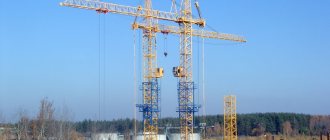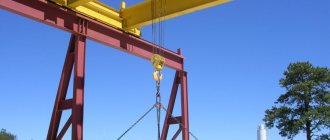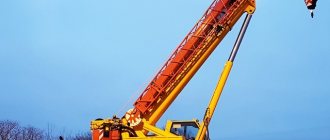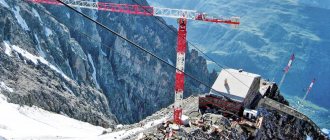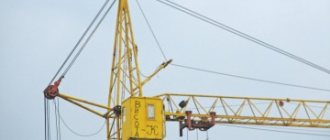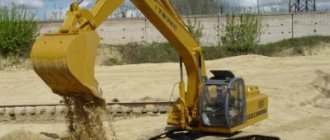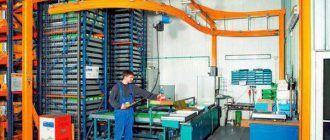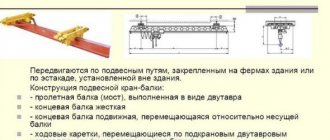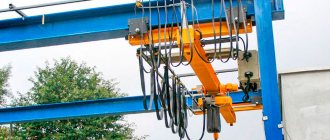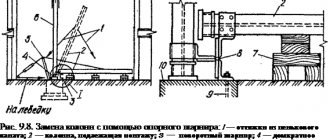What it consists of and how it works
Lifting cranes are powerful and mobile construction devices.
The main purpose of the equipment is the mechanization of processes during the construction of high-rise and multi-story buildings, the movement of materials and parts of structures to storage points or construction sites.
In mechanical engineering, a tower jib crane is a structure with a rotating tower and a long boom, which is secured at the top with hinges.
The structure of a tower crane looks like this:
- tower;
- portal frames;
- rotary support device (ROD);
- rotating platform;
- arrow;
- head, or hinged posts;
- cargo and trolley winches;
- running trolley;
- lifting device;
- counterweight consoles and struts;
- cabin.
The main processes performed by the manipulator:
- moving the load to the desired height;
- reducing or increasing the reach of the boom mechanism with load-handling suspension;
- full boom rotation 360°;
- movement around the site of a self-propelled vehicle.
They are equipped with a multi-motor drive with a planetary gear operating on alternating current with a voltage of 220/380 V.
The cranes are designed as follows.
The main part of the structure is the tower - a frame for holding the boom element at the required height and transmitting horizontal and vertical loads to the running portal with wheels and crane rail tracks. Stability and resistance to wind loads are checked by calculations when designing a metal structure and are ensured by rigid fastening to the portal frame or installation of diagonal braces to the rotating platform for articulated rotation. In the manufacture of the tower, steel angles and pipes are used.
Crane tracks
Mobile specialized machines equipped with a running rail device require the presence of special crane tracks at the construction site. Their high-quality execution will ensure safe and reliable operation of the equipment.
Crane tracks are constantly exposed to significant operational loads. Therefore, they must be regularly checked for any defects or changes in geometric parameters. Rail tracks are also equipped with grounding. It is necessary for protection, since this equipment is equipped with a large number of high-voltage elements.
Classification
Types and types of tower cranes, their description and classification are given in ST SEV 723-77.
Lifting manipulators are classified according to methods of movement on construction sites, types of load-bearing installations, design features of booms and towers, as well as rotation mechanisms and climatic design.
By purpose
Load-lifting mechanisms are of the following types:
- construction and installation;
- industrial general purpose;
- special.
If possible, move
Based on the methods of movement at construction sites, tower-type machines are divided into:
- stationary;
- self-elevating;
- mobile.
Stationary cranes are installed on a fixed base or foundation. When installed to a structure being built, they are called attached.
Self-lifting machines are attached to a multi-story or high-rise building, after which they independently move upward using their own drive.
Mobile devices move along a special platform. When operating on their own drive, they are classified as self-propelled, and when transported by a wheeled or tracked tractor, they are classified as trailed.
By type of running gear
The following walking portals exist:
- platforms on rails;
- automobile chassis;
- chassis on pneumatic wheels;
- platforms with caterpillar tracks;
- walking frames.
Lifting equipment
Cranes are:
- low power with a load capacity of up to 5 tons;
- medium power, 6-25 t;
- high power, 26-100 tons and more.
Types of taps
Based on the rotation mechanism, there are 2 types of manipulators:
- rotary;
- non-rotating.
In cranes with a fixed tower, the portals are U-shaped or in the form of a closed tent. The control unit is located on top of the tower.
In rotary-turret machines, the torque transmission unit is located at the bottom of the chassis.
How to choose
The choice of unit depends on the brand and performance of the model. When selecting a tower crane, pay attention to its indexing.
The symbol looks like this: KB1-234.567, where
- KB - tower crane, KEM - modular tower crane, KBR - tower crane for technical work, KBG - tower crane for hydraulic engineering construction;
- 1 - functional features of G, R, M;
- 2 — size group from 0 to 9 with load moment, in t*m;
- 3, 4 - serial number of the basic configuration (01...69 - with a rotating turret, 71...99 - with a fixed part);
- 5 — modernization A, B, C;
- 6 - climatic version.
According to Article 358 of the Tax Code of Russia, cranes fall under the concept of a vehicle and are therefore subject to transport tax.
Specifications
The main parameters and characteristics of tower cranes of basic models are presented in the table.
| Options | Mobile cranes | Attachment cranes | |||
| KB-100-32R | KB-160-40R | KB-1000-80R | KB-100-100P | KB-320-125P | |
| Maximum load moment, tm | 100 | 160 | 1000 | 100 | 320 |
| Load capacity, t | 5 | 10 | 50 | 5 | 12,5 |
| Reach, m, no less | 20 | 16 | 16 | 20 | 25 |
| Lifting height, m | 32 | 40 | 80 | 100 | 150 |
| Lowering depth, m | 5 | 5 | 8 | 5 | 5 |
| Travel speed, km/h | 16-32 | 16-40 | 10-20 | 25-50 | 32-50 |
| Rotation speed, rpm | 0,7 | 0,6 | 0,2 | 0,7 | 0,4 |
Operation, maintenance and repair
The operation of a crane leads to gradual wear and tear of parts, assemblies and systems, which subsequently causes the unit to age and fail.
To ensure normal performance throughout the entire service life, regulated maintenance of tower cranes is carried out - a set of planned preventive measures aimed at the efficient use of the unit, maintaining its reliability and serviceability during operation.
The maintenance system includes the following operations:
- prevention;
- Maintenance;
- control measures.
According to the operating manual for tower cranes, maintenance is carried out in accordance with the planned schedule, and repair work is carried out if necessary. All maintenance records are kept in a work log.
According to the regulations, maintenance is divided into the following types:
- daily (after each shift);
- periodic (TO-1, TO-2 are carried out on time);
- seasonal (2 times a year during the season change).
There are 2 types of planned repair operations:
- current;
- capital.
Shipping
The type of transportation of tower cranes depends on their overall dimensions, weight and design. Equipment can be delivered to remote construction sites in the following ways:
- by rail;
- by road train.
Lifting modules are transported by rail, having previously been installed on a special open platform, the dimensions of which should not exceed the dimensions of the rolling stock. At the factory, ballast and counterweights are removed from the cranes and, if necessary, disassembled into component elements with subsequent marking. Assembly units and mechanisms are placed on the platform and fixed.
When transporting cranes along highways, truck tractors with low-frame semi-trailers or single- and double-axle dollies are used.
Dimensions of the road train:
- length - up to 28 m;
- height - up to 4.2 m.
Tower crane: purpose, principle of operation, classification
This is a rotary lifting machine of the rifle type, the share of which in the fleet of modern mobile equipment reaches 18%. According to history, the first tower crane was designed by engineer Julius Wolf in 1913. The model he proposed in 1928 was equipped with a beam boom, later modified and in 1952 - also rotating. The design of these machines was constantly improved in accordance with the requirements placed on them. The purpose of the tower crane is to ensure the productivity of loading and unloading operations at landfills and construction sites, warehouses of various sizes. And over time, these problems had to be solved faster and safer, with ever-increasing weights.
This is how the design of tower cranes improved: for example, in the USSR, by 1960, their reliability was increased by 50% (compared to the first Soviet model, which appeared in 1936). And if before the Second World War they were produced on a non-specialized basis, then after they began to be produced by separate factories. By 1960, there were 28 such enterprises. And by 1980, machines of V-VI size groups, for example, KB-504 or KB-675, already had a working height of up to 150-180 m and a maximum possible load capacity of up to 40-50 tons (compared to 30 m and 1.5 t of the first models).
The structure of a tower crane and the principle of its operation
Any modern model has five key components:
- Tower - top- or bottom-moving telescopic or lattice tubular structure. Modern models can be of a buildable or expandable type, folded (dismantling is carried out directly on site) or not disassembled.
- Working boom - a structure of a lifting, beam or articulated type, equipped with a load trolley, made of pipes, or angles, or profiles. There are two types of it: hammer-shaped and pendant.
- The supporting part bears all vertical and tipping loads, so increased demands are placed on its reliability.
- A running device is a mechanism that ensures the movement and rotation of a tower crane. In practice, this is a rail or, less commonly, walking structure.
- The control cabin is a workspace for the operator issuing commands.
With the help of 3 types of mechanisms - we can distinguish blocks, winches, pulleys - basic operations are performed: in general, they come down to moving and turning the tower crane, vertical work, that is, raising and lowering the boom, as well as horizontal work - changing its reach , or moving the cargo trolley. The operator from the cabin gives the appropriate commands.
So, to rotate, the slewing support (slewing support) transfers certain vertical and tipping loads to the running frame (fixed part). The load is captured by a hook clip attached to the rope, and with the help of a winch it is moved up and down to the working height. The reach of the boom is also simply adjustable - by lowering and raising it, as well as moving the cargo trolley along it.
Classification of tower cranes
All the variety of modern models is divided into 3 groups.
By purpose:
- General purpose - for solving civil and general industrial problems, most often construction;
- Special - for effective performance of work of increased complexity;
- High-altitude (self-climbing, creeping, attached) - for tasks solved at high altitudes;
- Loaders are in demand for high-performance work, usually relevant in large warehouses.
If possible, move:
- Stationary - can be universal or attached;
- Mobile - can be trailed or self-propelled;
- Self-elevating - mounted directly on top of the object being built.
By type of running gear:
- On tracks
- On pneumatic wheels
- On rails
- On chassis
- Walking
- Automotive
It should also be noted that, in terms of their design features, today’s current lines of tower cranes can be classic, topless and quickly erected.
The classification is quite extensive, so indexing is carried out for all models. Tower cranes, depending on their role and performance, are marked in groups. Moreover, with the expectation that inside each there are similar assembly units, general circuit diagrams, unified or even similar block modules. Thus, almost every characteristic of a tower crane, regardless of its manufacturer, is predetermined, which facilitates its selection, operation and repair.
o-cranes.ru
Design of ball mixers
Ball mixers have been used relatively recently in plumbing. They quickly gained popularity due to their exceptional ease of use compared to valve devices. The design of a water ball valve is shown in detail in the diagram:
The central element in the design of a ball water tap is a cartridge that can be rotated both left and right and up and down.
Inside the case there is a spherical cartridge with three holes. Through two of them, cold and hot water enters the cavity of the cartridge, and through the third, the flow, already mixed and brought to the required temperature, is supplied to the spout.
Only one lever is used to control the movement of the cartridge. The left-right movement regulates the amount of cold and hot water entering the mixer, i.e. its temperature. To increase or decrease the water pressure, you need to move the lever up and down. This way you can adjust the temperature and pressure of the water flow with just a couple of movements.
Please note that due to the high popularity of ball mixers, many low-quality fakes have appeared on the market. The thickness of the metal body of such a device must be at least 2 mm. You can tell a good faucet by its weight: a high-quality model is heavier.
It should be noted that it is quite possible to repair a ball mixer at home. To do this, the device is disassembled and the ceramic cartridge is completely replaced with a new one. Of course, the cost of such repairs is much higher than replacing a conventional valve mechanism gasket. Cartridges of different models may differ, so when repairing it is recommended:
- disassemble the damaged mixer;
- remove the faulty cartridge;
- take it to a plumbing store;
- purchase an identical device;
- complete the repair.
When removing the cartridge, you need to remember its location in order to install the new element correctly.
The simplest model of a ball valve has been in use for quite some time. This is a simple mechanism that allows you to simply shut off the flow of water. Most often, such devices are used in pipelines, for example, in heating systems. The design of a crane of this type is shown in the diagram below:
Such a simple and reliable ball valve is not used to regulate temperature or water pressure, but only to open and close the flow
To stop the flow of water, just turn the handle 90 degrees. This simple design is usually not used very intensively, so it breaks extremely rarely.
technical specifications video, price, brands, photos, device (height and parameters)
The construction of civil and industrial buildings, the construction of residential multi-storey buildings, loading and unloading operations in warehouses, sites and landfills cannot be imagined without the use of tower cranes. They move loads and structural elements to the required point of the construction site.
Let's try to figure out what a tower crane is and find out its technical characteristics. The article will allow us to find out the parameters of tower cranes, their types and understand where and in what area their use will be most effective. And also find out the price of the “one-armed assistant”.
Technical characteristics of tower crane
The speed of work is determined by the power and productivity of the tower crane. The overall pace of construction and construction of buildings depends on his speed of movement and the weight he can lift. The video tower crane, which can be viewed below, is a cyclic type mechanism.
What is included in the concept of a mechanism’s operating cycle:
- This is a cargo grab.
- Moving a captured object.
- Unloading at the planned location.
- Return run.
| Tower crane technical characteristics of this type, its capabilities | |||
| 1 | Tower crane height (boom radius) | meter | 40 |
| 2 | Possible lifting height of the boom with a load | meter | 150 |
| 3 | Load lifting speed | meter/min | 10 — 100 |
| 4 | Rotation of the crane structure (its frequency) | rpm | 0,2 – 1,0 |
| 5 | Movement speed | meter/min | 10 — 30 |
| 6 | Load capacity of the cargo mechanism with minimal boom reach | kg | 7500 |
The characteristics of tower cranes that we consider are of several types:
- With a rotating tower.
- And a non-rotating design.
The prefabricated version of the structures allows for the installation and dismantling of the crane in a short time. Move it to the right place. Speaking about tower cranes as a type of lifting mechanisms, we add that a fixed tower is divided into three types:
- telescopic option;
- stackable design;
- growing.
KS truck crane: model range, characteristics, price, photo, video.
Everything about HOWO dump truck is here.
Way to travel
Rails are installed to move around the construction site. Along them, the crane can move back and forth, lifting and delivering building structures or loads to the desired point on the construction site.
There is a category of cranes that rests on the outside of the building under construction. This is classified as an attachment type design. In some cases, self-lifting mechanisms are used. As the height of the object under construction increases, they rise upward.
In addition to the cranes under consideration, there are mechanisms on pneumatic wheels. Cranes that move on tracks and are mounted on vehicles.
Tower crane structure
The design includes:
- support part;
- control cabin;
- slewing bearings;
- tower;
- arrow;
- running frames;
- device for moving along curves;
- turntables;
- stairs and platforms.
Tower crane brands
Today, many cranes of different brands are produced and located on construction sites. Photo tower cranes, which are presented at the end of the article, are the most in demand. We are talking about the KB series. This rotating cab series is believed to be the most commonly found on construction sites. These are the ones we will focus on.
T 130 bulldozer: technical characteristics, fuel consumption, price, photos, videos. You can find out what the largest truck cranes in the world are here.
The range of Liebherr truck cranes is here.
Technical characteristics of KB tower cranes
KB-100 is used in the construction of buildings whose height is 5 – 9 floors. Moves along the rail bed. KB-100 is a unit with an inclined boom and a rotating turret. Lifting height from 21 to 33 meters. Lifting speed 43 m/sec.
KB-402 crane on rails and a rotating tower. Can lift loads up to 8000 kg. The boom reach is 25 meters. Used in the construction of five-story buildings.
How much does a tower crane cost?
A tower crane, the price of which depends on its performance, lifting capabilities, year of manufacture and technical condition, can be purchased using credit funds. It is possible to lease or purchase used equipment. The spread is from 13897000.00 to 1287000.00 rubles. The average price of cranes in the Russian Federation is 670,000.00 rubles. It is common practice to rent a crane for a certain period.
Suffice it to say that any cranes, regardless of lifting capacity or speed of movement, are a sought-after tool, without which the construction of high-rise structures is impossible. Their use only speeds up the process of building construction.
More information on the website
spectechzone.com
Why doesn't he fall?
When trying to drop a multi-meter crane, many forces act on it. The biggest one is the weight of the load. In addition, when turning crane structures, centrifugal forces arise. As a result of braking when lifting or lowering a load, as well as when the crane is moving or turning, inertial forces appear.
Finally, atmospheric phenomena have a significant influence on the stability of the tower giant: wind, snow and ice on the structures. All these factors are taken into account when designing it:
- The design of any tower crane is based on the idea of balancing the weight of the load it has to lift. This task is performed by a counterweight. It shifts the center of gravity of the crane structure in its direction, creating a reserve of stability. It's called own. When the hook catches a load, the center of gravity shifts towards the load, but taking into account the counterweight it remains within acceptable limits. This is called load stability.
- Designers limit centrifugal forces to the speed of rotation of machine components, get rid of inertial forces, avoiding sudden stops of the cargo cable and crane mechanisms.
- Each tower crane has wind speed restrictions. In stormy winds, all work stops. In addition, the crane is designed so that it has the minimum possible windage.
Technology does not stand still. The theory and practice of constructing lifting mechanisms that make it possible to build tall buildings continues to develop, fulfilling the main task: to lift increasingly heavier loads as high as possible.
Construction of tower cranes
Mechanism for changing the reach and extension of the tower
Metal structure of tower crane
Tower crane safety devices
Tower cranes, being universal installation machines, are used for the installation of high and extended structures where jib self-propelled crawler and pneumatic wheeled cranes can be used.
Main advantages of tower cranes:
1) the boom is attached high to the crane tower, usually above the level of the structures being mounted, which allows them to be delivered to any point of the serviced territory in any sequence;
2) high load capacity with large boom radii;
3) ease of moving the crane;
4) clear organization of the installation site.
The disadvantages of tower cranes are the length and complexity of installation and dismantling, the difficulty of transporting them from site to site, and the high cost of tracks. All this significantly increases the cost of operating the crane and reduces its useful operating time. Modern models of tower cranes provide for transportation of cranes with minimal dismantling of components and the possibility of quick installation and dismantling without the use of additional mechanisms.
The wide variety of types of cranes makes them difficult to operate. To eliminate heterogeneity, a single series of tower cranes of the KB type has been approved. The type is based on the load moment. The type includes KB-4 cranes; KB-16; KB-25; KB-40; KB-60; KB-100; KB-160 and KB-250 (where the number indicates the load moment, i.e. the product of the maximum weight of the load being lifted and the reach corresponding to it, in tf).
KB type cranes are made from standardized units produced by specialized factories. Currently, cranes KB-60, KB-100 and KB-160 are produced.
According to their lifting capacity, tower cranes are divided into three groups: – for lifting light loads - less than 5 tons, with a load moment of up to 60 tf-m; – for lifting medium loads - from 5 to 25 tons, with a load moment of up to 300 tf-m; – for lifting heavy loads - more than 25 tons, with a load moment of more than 300 tf-m.
Tower cranes have become widespread in construction.
According to their purpose, tower cranes are divided into:
a) low-power cranes with a lifting capacity of up to 5 tons for servicing low-rise civil construction;
b) medium-power cranes with a lifting capacity from 5 to 25 g for servicing multi-story civil and industrial construction;
c) high-power cranes with a lifting capacity of 25–75 tons, and sometimes up to 100 tons, for the installation of prefabricated structural elements in hydraulic engineering and industrial construction.
In hydraulic engineering construction, low-power tower cranes are used to service auxiliary work; Medium power cranes are used primarily as concrete placing cranes for supplying concrete mixture in buckets to concreting blocks during the construction of monolithic concrete structures; High-power cranes are used as assembly cranes in the construction of precast concrete structures.
Heavy-duty assembly tower cranes are especially effective for servicing the construction of low-pressure hydraulic structures with a weight of prefabricated elements up to 70-80 tons and even 100 tons; they move on both sides of the structure.
Tower crane is a slewing crane with a boom attached to the top of a vertical tower (Fig. 1). The main parameters of a tower crane: lifting capacity, reach, load lifting height, load lowering depth, load lifting (lowering) speed, tower rotation speed, crane moving speed.
with a fixed tower and a rotating platform, attached, stationary, self-elevating, mobile
The main areas of use of tower cranes are the construction of residential buildings, the construction of industrial structures, hydraulic dams, and shipbuilding. There are many types of tower cranes. The classification is based on various characteristics.
Types of tower cranes by platform type
Depending on whether the platform of the tower crane rotates, the devices are:
- With a rotating platform. It consists of an all-welded frame and three beams. Trusses are attached to two beams. It is these elements that bear the load during crane operation. The platform has brackets that serve to fix the cargo and boom winches. Electrical appliances are also located here. The base for the tower is the lower counterweight.
- With a fixed tower. Despite the fact that the crane platform itself does not rotate, there is a rotating element. This is the head, which is located at the top of the tower. On one side, a counterweight is attached to the head, and on the other, an arrow. These elements balance each other. Cranes with a fixed platform are used in the construction of high-rise buildings and structures.
Such cranes are used in the construction of low buildings when the work is short in time. This is because slewing platform cranes can be quickly transported and assembled.
Diagram of tower cranes with a rotating platform and a non-rotating tower
Specifications
| Options | Slewing Cranes | Fixed tower cranes |
| Load capacity | up to 25 | up to 75 |
| Load lifting height, m | up to 90 | up to 220 |
| Boom radius, m | up to 40 | up to 80 |
Types of arrows
Tower crane booms can be classified according to the method of departure:
- Lifting. They are used to lift a load, but cannot move it horizontally. The operation of such an arrow is based on a mechanism that changes the angle of lift.
- Beam. This boom is installed statically in a horizontal position. It is not capable of changing the lifting height of the load. The boom has a movable mechanism that grips and moves the load along the skids.
The following classification of arrows is based on a design feature:
- hanging;
- suspended with balancer;
- hanging with a jib;
- hanging with stands;
- hammer-shaped
According to the type of arrow section there are:
- square;
- rectangular;
- triangular.
Tower crane booms can be installed in several ways.
The most cost-effective and fastest assembly method is to attach the boom and winch to the tower in a lying position on the ground.
The structure is lifted using its own winches. The second way is to build a constructor. That is, the crane elements are assembled one at a time in a vertical position at once, and the boom is raised last before connecting the electric current.
Types of cranes by tower type
Based on the design features of the towers, cranes are:
- Lattice. The tower is a structure that is assembled from corners and narrow tubes. The main elements of a lattice tower are the sides with upper and lower ribs, perpendicular and inclined rods. The lattice structure is both strong and lightweight. It reliably resists gusty winds.
- Solid-walled. Such towers have a very simple design, but are heavy. The towers are capable of lifting heavy loads. They are indispensable when working in low temperature conditions.
Classification of cranes depending on the support
Quite often, when distinguishing different types of tower cranes, a feature such as a support is used:
- Mobile. This type of tower cranes is characterized by the possibility of installing a mobile axle with wheels or a rail running under the frame. The crane is not disassembled during transportation; it is enough to remove the counterweights.
- Attached. The running gear of such tower cranes is completely absent. They are mounted on the foundation of the building being constructed, and the tower is fixed vertically to the supporting structures of the building.
- Self-elevating. Such cranes are installed in the middle of the building. They have a lifting ring that rests on the structure's floors. The winch helps move the tower up.
- Stationary. The cranes are attached to the foundation, but the tower is not fixed vertically.
Mobile, stationary, attached and self-climbing tower cranes
How are valve taps arranged?
Single valve faucet
Good old valve taps are distinguished by their simple design and fairly high reliability. Models with one valve are used for taps with cold or hot water only. The copper or brass body of the device contains a locking mechanism in the form of a faucet: worm or ceramic. The first option uses the principle of reciprocating motion. The valve controls a worm rod, which presses a rubber or leather gasket against a special “seat”. Gasket wear is the most common cause of valve failures. To stop water leaking from under a leaky gasket, you just need to replace it with a new one.
The ceramic faucet box consists of two plates with a clearance. One of the plates is fixed motionless, and the second is rotated using a valve. Both plates have gaps; when their positions coincide, water flows into the spout. Since ceramics are extremely resistant to wear, such a mechanism rarely breaks. Valve valves with a ceramic valve axle are more expensive than worm-type models, but they are much more reliable.
Single-valve faucets are used only to control the flow of cold or hot water. It is recommended to purchase more durable models with a ceramic valve axle box
The spout of such a faucet is sometimes cast as one piece with the body. In this case, the faucet spout will be stationary. Much more convenient and popular are models of valve taps with a spout in the form of a tube. The spout is inserted vertically into the product body and held in special grooves using two plastic hinge rings. This design allows you to rotate the spout in a horizontal plane, installing it in a position suitable for use.
Note! When choosing between a steel and brass model, you should give preference to the latter, since brass is much more resistant to corrosion.
Double valve mixer
Of course, in a house with hot water supply it makes sense to use a mixer. For two-valve devices, almost the same valve axle boxes are used as for valves with one valve. Cold water flows into the mixer through one locking mechanism, and hot water through the other. When controlling crane axle boxes, appropriate valves are used.
To repair a two-valve mixer, you also often have to change worn gaskets. However, sometimes it makes sense to completely replace the entire crane axle mechanism, which is relatively inexpensive. The procedure for this type of repair work is presented in detail in the following video:
This model is perfect for a kitchen sink or washbasin. Faucets with an additional hole for a shower hose are also installed in bathrooms. The design is complemented by a switch that directs the flow of water from the spout to the hose and back. Two-handle faucets have been used in plumbing for many years and continue to compete successfully with newer faucet options.
